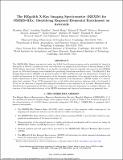The REgolith X-Ray Imaging Spectrometer (REXIS) for OSIRIS-REx: identifying regional elemental enrichment on asteroids
Author(s)
Allen, Branden; Grindlay, Jonathan E.; Hong, Jaesub; Inamdar, Niraj K.; Bautz, Marshall W.; Kissel, Steve E.; Oprescu, Miruna; Induni, Nicholas; Masterson, Rebecca A.; Chodas, Mark A.; Smith, Matthew William; Villasenor, Jesus Noel Samonte; Kissel, Steve E.; Binzel, Richard P; ... Show more Show less
DownloadBinzel_The regolith.pdf (13.31Mb)
PUBLISHER_POLICY
Publisher Policy
Article is made available in accordance with the publisher's policy and may be subject to US copyright law. Please refer to the publisher's site for terms of use.
Terms of use
Metadata
Show full item recordAbstract
The OSIRIS-REx Mission was selected under the NASA New Frontiers program and is scheduled for launch in September of 2016 for a rendezvous with, and collection of a sample from the surface of asteroid Bennu in 2019. 101955 Bennu (previously 1999 RQ36) is an Apollo (near-Earth) asteroid originally discovered by the LINEAR project in 1999 which has since been classified as a potentially hazardous near-Earth object. The REgolith X-Ray Imaging Spectrometer (REXIS) was proposed jointly by MIT and Harvard and was subsequently accepted as a student led instrument for the determination of the elemental composition of the asteroid's surface as well as the surface distribution of select elements through solar induced X-ray fluorescence. REXIS consists of a detector plane that contains 4 X-ray CCDs integrated into a wide field coded aperture telescope with a focal length of 20 em for the detection of regions with enhanced abundance in key elements at 50 m scales. Elemental surface distributions of approximately 50-200 m scales can be detected using the instrument as a simple collimator. An overview of the observation strategy of the REXIS instrument and expected performance are presented here.
Date issued
2013-09Department
Massachusetts Institute of Technology. Department of Aeronautics and Astronautics; Massachusetts Institute of Technology. Department of Earth, Atmospheric, and Planetary Sciences; Massachusetts Institute of Technology. Space Systems Laboratory; MIT Kavli Institute for Astrophysics and Space ResearchJournal
Proceedings of SPIE--the International Society for Optical Engineering
Publisher
SPIE
Citation
Allen, Branden, Jonathan Grindlay, Jaesub Hong, Richard P. Binzel, Rebecca Masterson, Niraj K. Inamdar, Mark Chodas, et al. “The REgolith X-Ray Imaging Spectrometer (REXIS) for OSIRIS-REx: Identifying Regional Elemental Enrichment on Asteroids.” Edited by Mark A. Kahan and Marie B. Levine. Optical Modeling and Performance Predictions VI (September 27, 2013). © 2013 SPIE
Version: Final published version
ISSN
0277-786X